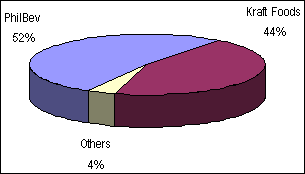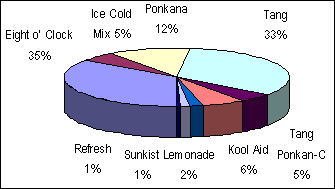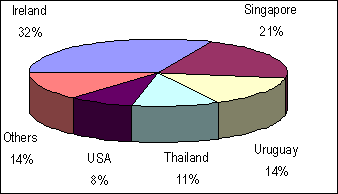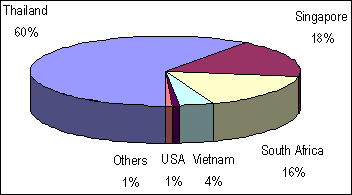

The Powdered Segment of the Fruit Juice Industry*
February 2005
Ronald Mark G. Omaña
Researcher
Center for Food and Agri Business
University of Asia and the Pacific
Juices enjoy wide exposure especially in supermarkets and groceries. They could be found in the dry section, usually occupying a big portion of a long shelf, and even in the chilled section.
There are five types of juices sold in the market, namely: fruit juice; fruit juice from concentrate; fruit nectar; concentrated fruit juice; and dehydrated or powdered fruit juice.
The Food Safety Authority of Ireland describes the juice types as follows:
Table 1. Juice Types and Description
Fruit juice
- The extracted juice of fruit, which has not been concentrated. Has a shelf life of "days"
- May not contain any artificial flavors, colors or additives other than carbon dioxide and acidifying agents
Fruit juice from concentrate
- Juice which has been concentrated and returned to its original state by the addition of water
Fruit nectar
- Obtained by adding water and sugar and/or honey to fruit juice, fruit juice from concentrate, concentrated fruit juice, dehydrated/powdered fruit juice, fruit puree or a mixture of these products
Concentrated fruit juice
- Product obtained from fruit juice of one or more kinds by the physical removal of a specific proportion of the water content.
- It is necessary to dilute this product with water before consumption
Dehydrated / Powdered fruit juice
- Product obtained from fruit juice of one or more kinds by the physical removal of virtually all the water content. The resulting product will be in powder form and will require the addition of water before use.
Source: Food Safety Authority of Ireland (www.fsai.ie)
Household spending on fruit juices and non-carbonated drinks (powdered, concentrated, and ready-to-drink) was estimated at P7.2 billion in 2000 from P5.1 billion in 1997 (National Statistics Office (NSO)- Family Income and Expenditure Survey). It accounted for 29% of the entire family spending on non-alcoholic beverages, up from 26% in 1997.
One of the most popularly consumed juices is the dehydrated/powdered fruit juice since it is usually sold in smaller packs at relatively lower prices compared to other juice types. In addition, there are several variants available in the market.
The Players
The industry is dominated by two major players, namely, San Miguel Corporation subsidiary Philippine Beverage Partners Inc. (PhilBev) and multinational firm Kraft Foods (Philippines) Inc. Other players include large companies in the food and beverage industries such as Nestle Phils. Inc., RFM Corporation, and Universal Robina Corporation. Procter and Gamble Philippines, Inc. also entered the market in 1999 but stopped in just a few years' time. Relatively new players in the market include Zest-O Corporation, Liwayway Marketing Corporation, and Ajinomoto Philippines Corporation.
Philippine Beverage Partners Inc. is a subsidiary of Southeast Asia's largest food and beverage company San Miguel Corporation (SMC). It owns the popular Eight o' Clock brand as well as the Ponkana and Ice Cold Mix brands. PhilBev also manages other non-carbonated products of San Miguel such Fun Chum and Magnolia ready-to-drink fruit drinks and Wilkin's distilled water and Viva! Mineral water. PhilBev's juice brands were originally owned by Sugarland International Products Inc. but were acquired by parent firm SMC together with another SMC subsidiary La Tondeña Distillers Inc. (now Ginebra San Miguel Inc.) in May 2000 for P2.9 billion. PhilBev has eight flavors for its Eight o' Clock brand (orange, pineapple, dalandan, pomelo, calamansi, lemonade, orange-mango, and orange-pineapple) while its Ice Cold Mix comes in pomelo and pineapple flavors. Ponkana is tangerine orange-flavored.
Kraft Foods (Philippines) Inc. owns and produces powdered juices using the Tang, Tang Ponkan-C, and Kool-Aid brands. Its powdered juices are imported from Thailand except for those in one-liter packs which are toll-manufactured locally. Aside from the tangerine orange flavor (Tang Ponkan-C), Tang comes in seven other flavors, namely, orange, pineapple, grape, guyabano, pomelo, lemon, and mango.
RFM Corporation is the Philippine licensee of Sunkist Growers Inc. to manufacture powdered and ready-to-drink juices using the Sunkist brand. Sunkist powdered juices are available in eight flavors (orange, pineapple, dalandan, pomelo, lemonade, four seasons, watermelon, and green mango). RFM recently launched its Sunkist singles in 9-gram packs.
One of the newer players in the powdered juice segment, Ajinomoto Philippines Corporation launched its powdered juices in September 2003 using the Fres-C brand initially in orange, pomelo, and pineapple flavors. In February 2005, the company added three new flavors - calamansi, guava, and lychee.
Liwayway Marketing Corporation (LMC), known as the manufacturer of Oishi snack food products, entered the powdered juice segment in early 2003 using the Sundays brand. Sold initially in one-liter packs and in three variants (orange, pineapple and lemonade), Sundays has recently introduced its powdered drinks in 250-gram and 500-gram packs. The company also launched two additional flavors, namely, dalanghita and mango. LMC claims it is the first to introduce mango flavored powdered juice in the market, ahead of industry leaders PhilBev and Kraft Foods.
Universal Robina Corporation (URC) launched its powdered juice Refresh in mid-2000 in two flavors - orange and dalandan in 250-gram and 400-gram packs. In early 2004, however, the company ceased manufacturing the powdered drink to re-think its strategy for the product. Despite of this, the Refresh brand remains visible as it is being used by URC for its ready-to-drink juice and packaged water.
Zest-O Corporation is the leader in the ready-to-drink juices in doy-packs (flexible foil pouch). It has powdered juices using the Sunglo brand. At present, Sunglo is available in three flavors (orange, strawberry, and lemon). The product used to have the pineapple flavor until early this year when it ceased producing the said variant. All flavors come in 250-gram, 500-gram, and 750-gram packs.
Another multinational company, Procter & Gamble Philippines Inc. entered the powdered juice segment in 1999 thru its Nutri Delight brand. The product was positioned as a fortified powdered orange drink with Iron, Vitamin A, and Iodine. A few years later, however, the company stopped producing Nutri Delight.
The Market
The market for powdered juices is estimated to be worth at least P8 billion in 2004. PhilBev and Kraft are the market leaders. In 2003, PhilBev's market share was around 52% while Kraft Foods had 44%. The remaining 4% was shared by other players in the market.
Figure 1. Estimated Market Shares in the Powdered Juice Segment by Player, 2003

Source: Key Industry Informant
On a per brand basis, PhilBev's Eight o' clock controlled about 35% of the entire powdered juice market, followed by Kraft's Tang with 33%. Another PhilBev brand, Ponkana, captured 12% market share while Kraft's Kool Aid has 6%. Meanwhile, Tang Ponkan-C and Ice Cold Mix each had 5% market share. Other brands such as Nestle's Lemonade, RFM's Sunkist and URC's Refresh share the remaining 4% of the market.
Figure 2. Estimated Market Shares in the Powdered Juice Segment by Brand, 2003

Source: Key Industry Informant
In terms of flavor, industry players say the largest-selling powdered juice flavor remains to be orange while other flavors like pineapple are also performing well.
Trade
Powdered juices are classified by the NSO under the Philippine Standard Commodity Classification Code 0989905 as preparations for the manufacture of lemonades or other beverages consisting, for example, of flavored or colored syrup, syrup-flavored with fruit juices.
Trade data revealed that imports outpaced exports for an entire five-year period beginning 2000.
| IMPORTS | EXPORTS | |||
|---|---|---|---|---|
| Year | Volume | Value | Volume | Value |
| (In tons) | (In US$ CIF '000) | (in tons) | (In US$ FOB '000) | |
| 2000 | 29,498 | 49,265 | 270 | 1,383 |
| 2001 | 45,186 | 64,566 | 283 | 1,365 |
| 2002 | 51,342 | 65,206 | 123 | 776 |
| 2003 | 43,791 | 69,981 | 51 | 250 |
| 2004 | 16,646 | 19,821 | 278 | 1,058 |
Source: NSO
Imports. From nearly 29,500 tons (US$ (CIF) 49.2 million), imports increased by 53% to about 45,200 tons (US$64.6 million) in 2001. Growth was fuelled by increased shipments from country-suppliers like the United States of America (USA), Brazil, Ireland, United Kingdom, New Zealand, Thailand, Malaysia, and Taiwan. In 2002, volume growth slowed down to about 14% to 51,300 tons (US$65.2 million). The following year, imports contracted by nearly 15% to 43,800 tons (US$70 million), due to the huge drop in purchases from Canada, Brazil, Ireland, United Kingdom, Japan, Singapore, Taiwan, and South Korea. In 2004, imports plunged further by 62% to 16,600 tons (US$19.8 million). Only Canada, Brazil, France, New Zealand, India, and Taiwan managed to increase their shipments into the country.
The major sources of powdered juice in 2004 were Ireland, with 32% share on value, followed by Singapore (21%), Uruguay (14%), Thailand (11%), and the USA (8%). Other countries contributed 14% of total import value.
Figure 3. Imports of Powdered Juices by Country of Origin, 2004

Source: NSO
Exports. In 2000, exports reached 270 tons valued at US$ (FOB) 1.38 million. The following year, volume improved to 283 tons (US$ 1.36 million) before contracting by nearly 57% to 123 tons (US$ 776,000) in 2002. The decline was caused by reduced purchases by major buyers like Singapore, Thailand, Taiwan, and Hong Kong. By 2003, shipments further dropped by 59% to 51 tons (US$ 250,000) due to lower purchases of Taiwan and Hong Kong and non-purchase of South Korea, despite improved exports to Thailand and new shipments to Malaysia, Brunei, Myanmar, Ireland, and Puerto Rico. In 2004, exports grew by more than five times to 278 tons (US$1.1 million), boosted by large purchases by Thailand, Singapore, Vietnam, and South Africa.
The largest buyer of powdered juice in 2004 was Thailand, which contributed 60% to total export value. Other buyers included Singapore (18%), South Africa (16%), Vietnam (4%), and the USA (1%).
Figure 4. Exports of Powdered Juice by Country of Destination, 2004

Source: NSO
Marketing Trends
The industry is characterized by stiff competition, particularly in the market for economy packs or powdered drinks in sachets. Almost all manufacturers have small-serve one liter or litro packs (45 grams), which are sold at very affordable prices of less than P10. Table 3 shows the retail prices of selected powdered juice brands for various pack sizes.
For orange powdered juice in 45-gram pack, the cheapest is Sundays at P6.75 per pack, followed by Fres-C (P7.00), Tang (P7.90), and Eight o' Clock (P8.25). Interestingly, Sunkist, which was not available at the supermarket at the time the survey was done, is being sold at a cheaper price of P6.00 per pack in some groceries.
For the 500-gram pack, Eight o' Clock is more expensive by P0.25 compared to the P38.25 retail price of Tang.
For the 750-gram pack, Sunglo is more affordable at P49.75 compared to P62.50 for Tang. Eight o' Clock and the other brands do not have this pack size.
Finally, for the 1-kilogram pack, Eight o' Clock is sold cheaper by P3.25 at P76.50 compared to Tang's P79.75.
| Pack Size | ||||
|---|---|---|---|---|
| Brand | 45 grams | 500 grams | 750 grams | 1 kilogram |
| Eight o' Clock | 8.25 | 38.50 | - | 76.50 |
| Tang | 7.90 | 38.25 | 62.50 | 79.75 |
| Sundays | 6.75 | - | - | - |
| Fres-C | 7.00 | - | - | - |
| Sunglo | - | - | 49.75 | - |
| Sunkist | - | - | - | - |
Source: Major supermarket in Mandaluyong City, April 2005
Players also promote their products as healthy and good for the body, emphasizing on the vitamin and mineral contents of their products.
A look at the labels of three popular brands (Eight o' Clock, Tang, and Sunkist) revealed the following nutrition facts:
| Vitamin / Mineral | Eight o' Clock | Tang | Sunkist |
|---|---|---|---|
| Vitamins | |||
| Vitamin C |  |
 |
 |
| Vitamin A |  |
 |
|
| Vitamin B2 |  |
 |
|
| Folic Acid |  |
 |
|
| Niacin |  |
 |
|
| Vitamin B6 |  |
 |
|
| Vitamin E |  |
 |
|
| Beta-Carotene |  |
 |
 |
| Minerals | |||
| Calcium |  |
 |
|
| Phosphorus |  |
Source: Product labels
Another "healthy" selling proposition employed for powdered juice drink is promoting it as low calorie. This is currently being used by PhilBev for its Eight o' Clock and Ponkana products, as well as Ajinomoto's Fres-C.
Lastly, product extension or the introduction of new flavors has been used as a tool to attract consumers. While the leading brands have the most number of variants, the new players are utilizing this approach to gain market share. Ajinomoto, for instance, recently introduced flavors never before seen in the market like lychee and guava, while Zest-O Corporation's Sunglo has a strawberry flavor. At the same time, Eight o' Clock has combined-flavored drinks like orange-mango, and orange-pineapple.
Prospects
Research firm AC Nielsen reported that the market for powdered juice drinks is still growing although at a slower rate compared to ready-to-drink juices. According to players, they expect the segment to post continued growth in the next three to five years. Performance will be driven mainly by strong demand for economy packs while those in bigger packs will continue to post steady growth rates.
The entry of new players, despite the pull-out of URC, indicates a growing market. Existing players view this as a challenge since more would mean more product options for the consumer.
Industry sources say innovation would remain vital for success. Most importantly, the trend towards healthier, better-for-you products is still expected to fuel growth as powdered juice presents itself as a "better" beverage than substitutes like ice tea and carbonated drinks.
In early 2004, with the passage of Executive Order No. 295 which raises the tariff rate on pre-mixed sugar, which is used mainly for powdered juices, from zero to 65%, the major players dispelled concerns of any price increase due to the EO. Now, there is a pending bill in Congress which seeks to prohibit the use of aspartame, a sweetener used in powdered juices. If approved, players say such a scenario may lead cost to increase by 30% to 40% as they will have to shift to refined sugar which costs more than the artificial sweetener.
Overall though, industry players project a bright future for their business. In the short- term, sales are expected to move-up as consumers gulp more of powdered juice drinks as the summer heat intensifies.
References:
National Statistics Office
Food Safety Authority of Ireland ( www.fsai.ie)
* Publié dans le numéro de février 2005 de la revue mensuelle Food and Agri Business Monitor du Center for Food and Agri Business, University of Asia and the Pacific, Pasig City, Philippines.
| Date Modified: 2005-08-30 | Important Notices |